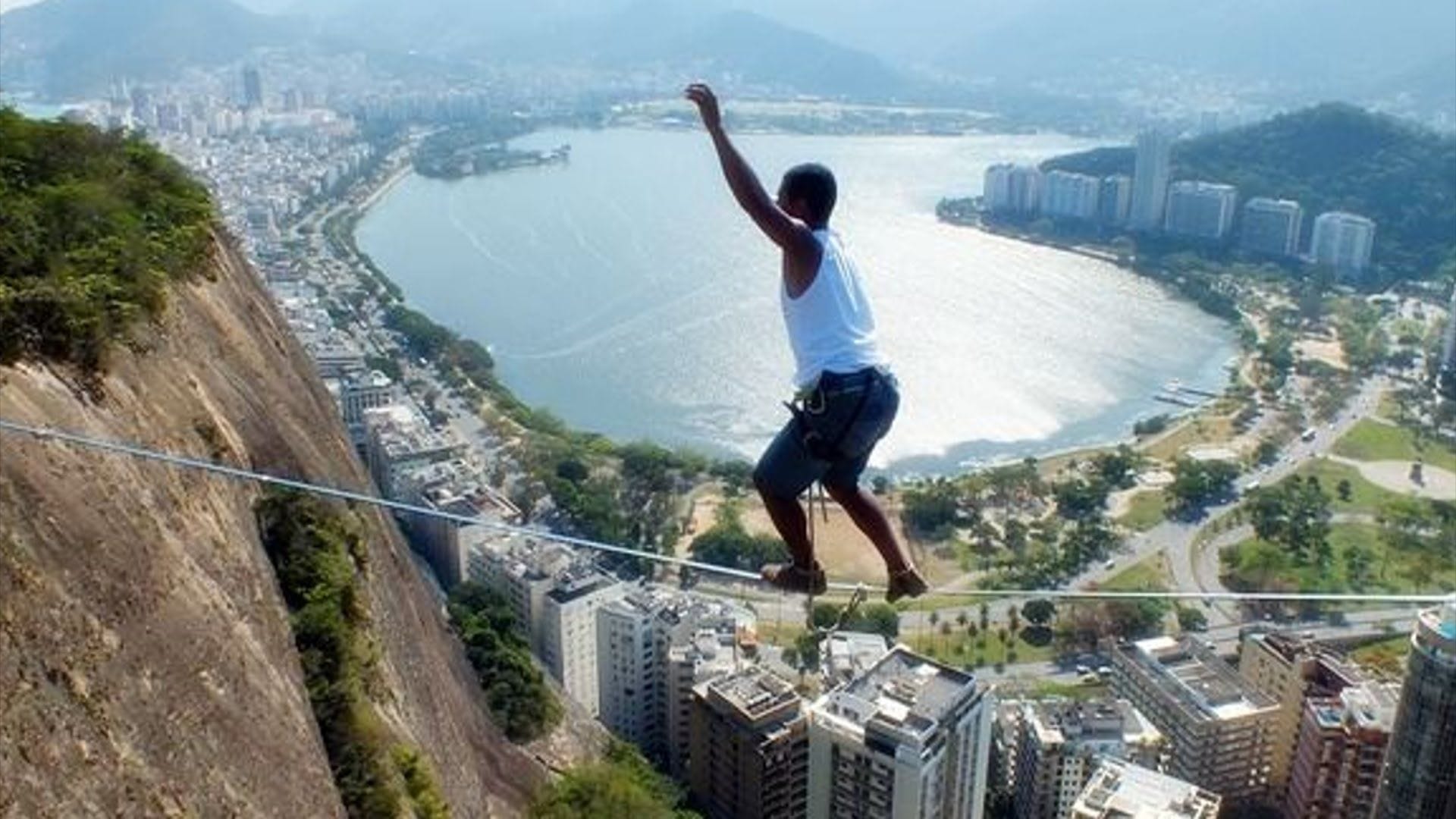Get ready to face your fears and soar to new heights with this beginner’s guide to highlining. It’s like walking a tightrope, but way cooler! We’ll teach you everything you need to know, from the basics of safety to different styles of highlining. Whether you’re a complete newbie or a seasoned adrenaline junkie, this guide will help you conquer the thrill of the heights and experience the freedom of balancing way up in the sky.
What is Highlining?
Ever dream of walking a tightrope, but like, way, way up high? That’s highlining in a nutshell! It takes the balance and core strength of regular slacklining and cranks it up to eleven. Imagine this: you’re standing on a narrow strip of webbing, hundreds, maybe even thousands of feet in the air. Yeah, that’s highlining. You’ll need serious mental focus too, because, let’s be real, heights can be a little intimidating!
Slacklining vs. Highlining: What’s the Difference?
So, you’ve been bitten by the balance bug and are curious about the difference between slacklining and highlining? Both activities involve walking, balancing, and even doing tricks on a narrow, tensioned piece of webbing, but the height at which they’re set up creates a world of difference.
Think of it this way: slacklining is like walking on a tightrope set up a foot off the ground in your backyard—challenging but approachable. Highlining, on the other hand, is like walking that same tightrope strung between two skyscrapers—exhilarating and requiring a whole other level of skill and courage.
Here’s a closer look at the key differences:
| Feature | Slacklining | Highlining |
|---|---|---|
| Height | Low to moderate (usually under 10 feet) | Very high (typically hundreds or thousands of feet) |
| Safety | Minimal risk, often practiced without a harness | High risk, requires specialized safety equipment and redundancy, fall results in suspension |
| Equipment | Basic webbing, ratchets, and potentially padding | Advanced webbing, specialized rigging gear, harnesses, backup systems |
| Skill Level | Beginner to advanced, wide accessibility | Experienced slackliners only, significant physical and mental training required |
| Focus | Balance, coordination, potentially tricks | Mental fortitude, risk management, facing fear, technical skill |
Why Highline?
Why would anyone willingly put themselves in such a precarious position? Well, for highliners, it’s about pushing personal boundaries and experiencing an unparalleled sense of freedom. Picture yourself high above the world, the wind whipping around you, completely focused on each step. It’s about conquering fear, building incredible balance, and taking in some pretty breathtaking views along the way. It’s a journey of self-discovery that can:
- Unleash Your Inner Confidence: Every step you take on the line is a victory, pushing you beyond your perceived limits and showing you just how strong and capable you truly are.
- Live in the Moment: When you’re hundreds of feet up, there’s no room for distractions. Highlining demands your complete and utter presence, allowing you to experience the present moment with a clarity you won’t find anywhere else.
- Find Your Tribe: The highlining community is full of supportive, adventurous souls who share your passion for pushing boundaries. You’ll find mentors, friends, and maybe even a few friendly rivals along the way.
Gearing Up for Safety
Before you even think about stepping foot on a highline, safety has to be your top priority. No exceptions. Highlining comes with inherent risks, but by following these guidelines and using appropriate gear, you can significantly minimize them:
- Redundancy is Key: Think of it like this: you wouldn’t bungee jump with just one cord, right? Same goes for highlining. Always use multiple safety systems so that if one fails, you have backup. Think redundant anchors and webbing.
- The Buddy System Saves Lives: Always, and we mean always, have an experienced highliner double-check your setup. A fresh pair of eyes can catch potential issues you might have missed.
- Protect Your Gear (and Yourself!): The last thing you want is your webbing getting frayed on a sharp edge. Use specialized padding and covers to protect your gear from abrasion — it could save your life!
- Rigging Ain’t a Solo Sport: Never, ever try to rig a highline by yourself. Always work with experienced riggers who know the ins and outs of setting up safe and secure lines.
Speaking of gear, you’ll need specialized equipment designed for this extreme sport. This includes:
| Gear | Description |
|---|---|
| Highline Webbing | Super strong webbing specifically designed to handle the tension of highlining |
| Harness | Keeps you connected to the line, just like when you’re rock climbing |
| Leash | A secondary connection to the line for added safety |
| Carabiners & Pulleys | Used for setting up and tensioning the highline |
| Backup Systems | Redundant safety measures in case the primary system fails |
Think of your gear as your best friend when you’re hundreds of feet in the air. Each piece plays a crucial role in keeping you safe, so never skimp on quality or cut corners when it comes to your equipment.
People’s Statement: “One thing first: Highlining is a potentially dangerous sport. Accidents don’t happen too often, but if a mistake is made when setting up the highline, it can be fatal in the worst case.” – SLACKTIVITY
Finding Your Footing: Styles of Highlining
Think highlining is a one-size-fits-all sport? Think again! Just like any adventure activity, there are different styles to explore:
- Tricklining: If flips, spins, and showing off your mad skills get you going, then tricklining is your jam. It’s basically taking all the cool tricks you can do on a regular slackline and, you guessed it, doing them way up high.
- Freesolo: We’re not going to sugarcoat it—this is the extreme end of highlining. Freesoloing means walking the line without a safety leash. It’s incredibly dangerous and definitely not recommended for beginners (or, honestly, most people!).
What to Expect on the Line
So, you’ve got your safety gear, you’ve found an awesome spot, and you’re ready to step onto the highline. What can you expect?
- A Mental Workout Like No Other: Highlining is as much a mental game as it is physical. You’ll need to conquer your fear, quiet those pesky doubts, and stay laser-focused on every step. It’s challenging, but the sense of accomplishment is incredible.
- Get Ready to Feel the Burn: All that balancing and adjusting takes serious core strength, stability, and stamina. Don’t worry, though – you don’t need to be a superhuman athlete to start highlining. Regular slacklining, yoga, and core workouts are great ways to build the strength you’ll need.
- Nature’s Eye Candy: One of the best things about highlining? The views! Highlines are often set up in breathtaking natural locations, giving you a unique and unforgettable perspective on the world around you.
If you’re suffering from plantar fasciitis, you might want to consider HOKA ONE ONE sneakers. They’re specifically designed to provide support and cushioning for your feet, which can help to relieve pain and discomfort. With their unique design, these sneakers might help you get back on your feet and pain-free in no time.
Highlining Etiquette: Being a Responsible Adventurer
As highlining becomes more popular, it’s important to remember that with great height comes great responsibility (yes, we went there!). Here’s how to be a respectful highliner:
- Tread Lightly: Remember, you’re a guest in nature’s playground. Minimize your impact by packing out everything you pack in, staying on designated trails, and respecting wildlife.
- Rules Are There for a Reason: Always check local regulations and permits before setting up a highline. Some areas may have restrictions or require special permissions.
- Safety First, Always: Be a positive ambassador for the sport by encouraging others to follow safety guidelines and promoting responsible highlining practices.
Taking the Leap
Ready to give highlining a go? Awesome! Here’s a suggested path to get you started:
- Find Your Footing (Literally): Start with slacklining, the grounded version. It’s a great way to build the balance and coordination you’ll need for its elevated counterpart.
- Learn from the Pros: Find a reputable highlining course or an experienced mentor. They’ll teach you the essential skills and safety procedures. Remember, learning from those who’ve already walked the line (pun intended) is invaluable.
- Join the Club: Connect with other highliners. It’s not just about finding people to climb with; it’s about learning from shared experiences and getting advice from those who understand the sport’s unique challenges and rewards.
People’s Statement: “On a highline this reference is much further away and is, therefore, less helpful at the beginning. One way to get used to that, is by closing your eyes while walking in the park. Another way is to start waterlining, which is actually more difficult than highlining. And upon that, you can learn to relax your gaze.” – SLACKTIVITY
Highlining is definitely not for everyone, and that’s okay. But for those who feel drawn to its unique blend of physical and mental challenges, the rewards can be immeasurable. It’s a sport that demands respect, careful preparation, and a healthy dose of courage, but the view from the top? Well, let’s just say it’s pretty extraordinary.
- Unlock Water’s Symbolism: A Cross-Cultural Exploration - April 20, 2025
- Identify Black and White Snakes: Venomous or Harmless? - April 20, 2025
- Unlocking Potential: Origins High School’s NYC Story - April 20, 2025















